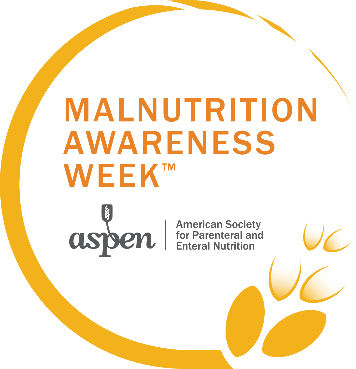Malnutrition Awareness WeekTM (September 18-22 this year) is designed to educate professionals and consumers about how to identify and address malnutrition — a health condition caused by not getting enough nutrients from foods. The consequences of malnutrition can be dire, especially for older adults — malnutrition diminishes the function of every organ system, increases risk of falling, causes depression and anxiety, and more. In addition, health care costs for people who are malnourished are nearly 75% higher.
professionals and consumers about how to identify and address malnutrition — a health condition caused by not getting enough nutrients from foods. The consequences of malnutrition can be dire, especially for older adults — malnutrition diminishes the function of every organ system, increases risk of falling, causes depression and anxiety, and more. In addition, health care costs for people who are malnourished are nearly 75% higher.
Risk factors for malnutrition include eating alone, social isolation, depression, chronic health conditions, a history of falls, food insecurity, and overly restrictive diets, as well as other factors that can affect the amount and types of foods eaten, such as access to transportation — all of which are more common in older adults. It’s not surprising, therefore, that people 65 and older are far more likely than any other age group to be malnourished.
ACL’s senior nutrition programs, which are funded by the Older Americans Act (OAA), provide home-delivered and congregate meals, as well as nutrition education and counseling. They are a critical link between communities and healthy food, and they provide connections to other home and community-based services that support overall health and wellness. The programs have been proven to reduce malnutrition — and those of us in the aging network see the positive impact first-hand!
Because good nutrition is required to maintain good health, language about malnutrition was included in the 2020 reauthorization of the OAA. In only a few years, this has allowed for the expansion of prevention strategies at the national, state, and local levels. For example, state and local activities that have resulted include malnutrition prevention coalitions, the addition of validated malnutrition screening tools, social media awareness campaigns, innovative service delivery models to allow nutrition services to reach those most in need, and the development of referral networks (for when malnutrition is identified). And some state units on aging (SUAs) participated in an ACL-funded learning collaborative formed to assist SUAs in adding actions to state plans on aging to address malnutrition.
Despite these achievements, there is work yet to do. We must continue to plan for the future — and prepare for a larger and ever more diverse population of older Americans.
Fortunately, the creative and innovative approaches the aging network is developing today are paving the way. And at ACL, we are working to identify and facilitate partnerships to address gaps in nutrition program research. In addition, our Innovations in Nutrition Services and Programs grants are demonstrating how traditional and emerging forms of nutrition services help to improve nutritional health.
Our Nutrition and Aging Resource Center has also launched a redesigned website with an array of ready-to-use, virtual, and in-person nutrition education resources for older adults. It offers many resources for addressing malnutrition, and the center’s library is always expanding. For example, this fall, we’re releasing a toolkit on restaurant partnerships. It will include tip sheets, templates, infographics, checklists, and other materials to support community nutrition providers who wish to partner with restaurants to enhance access to healthy meals for older adults in their communities.
We hope you can use these resources to join us in getting the word out to your networks and communities about the importance of nutrition and the services available through the OAA senior nutrition programs. We are proud to partner with you to combat malnutrition!

